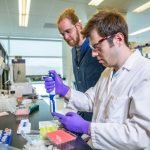Summary: Etienne Wenger summarizes Communities of Practice (CoP) as “groups of people who share a concern or a passion for something they do and learn how to do it better as they interact regularly.” This learning that takes place is not necessarily intentional. Three components are required in order to be a CoP: (1) the domain, (2) the community, and (3) the practice.
Originators: Jean Lave and Etienne Wenger in 1991 and further elaborated in 1998.
Key Terms: domain, community, practice, identity, learning
Communities of Practice
The term was first used in 1991 by theorists Jean Lave and Etienne Wenger who discussed the notion of legitimate peripheral participation[1]. In 1998, the theorist Etienne Wenger extended the concept and applied it to other domains, such as organizations[2]. With the flourishing of online communities on the Internet, as well as the increasing need for improved knowledge management, there has been much more interest as of late in communities of practice. People see them as ways of promoting innovation, developing social capital, facilitating and spreading knowledge within a group, spreading existing tacit knowledge, etc.
Communities of Practice can be defined, in part, as a process of social learning that occurs when people who have a common interest in a subject or area collaborate over an extended period of time, sharing ideas and strategies, determine solutions, and build innovations. Wenger gives a simple definition: “Communities of practice are groups of people who share a concern or a passion for something they do and learn how to do it better as they interact regularly.” Note that this allows for, but does not require intentionality. Learning can be, and often is, an incidental outcome that accompanies these social processes.
One needs to distinguish between what is a CoP and what is not. There are three required components of CoPs:
- There needs to be a domain. A CoP has an identity defined by a shared domain of interest (e.g. radiologists, Star Trek fans, middle school history teachers, Seahawks football fans, etc.); it’s not just a network of people or club of friends. Membership implies a commitment to the domain.
- There needs to be a community. A necessary component is that members of a specific domain interact and engage in shared activities, help each other, and share information with each other. They build relationships that enable them to learn from each other. In this way, merely sharing the same job does not necessitate a CoP. A static website on hunting in itself is not a community of practice. There needs to be people who interact and learn together in order for a CoP to be formed. Note that members do not necessarily work together daily, however. Wenger points to the example of Impressionist painters who sometimes met in cafes to discuss their painting styles. He indicates that even though these men normally painted alone, these kinds of interactions were essential to making them a CoP.
- There needs to be a practice: A CoP is not just people who have an interest in something (e.g. sports or agriculture practices). The third requirement for a CoP is that the members are practitioners. They develop a shared repertoire of resources which can include stories, helpful tools, experiences, stories, ways of handling typical problems, etc. This kind of interaction needs to be developed over time. A conversation with a random stranger who happens to be an expert on a subject matter that interests you does not in itself make a CoP. Informal conversations held by people of the same profession (e.g. office assistants or graduate students) help people share and develop a set of cases and stories that can become a shared repertoire for their practice, whether they realize it or not.
Communities develop their practice through a variety of methods, including: problem solving, requests for information, seeking the experiences of others, reusing assets, coordination and synergy, discussing developments, visiting other members, mapping knowledge and identifying gaps.
For Etienne Wenger, learning is central to human identity. A primary focus is learning as social participation – that is, an individual as an active participant in the practices of social communities, and in the construction of his or her identity through these communities. People continuously create their shared identity through engaging in and contributing to the practices of their communities. The motivation to become a more central participant in a community of practice can provide a powerful incentive for learning. Students will have a desire to develop skills (e.g. literacy skills) if the people they admire have the same skills. That is, they want to join the “literacy club” and will work towards becoming a a member.
For more information, we recommend:
- Etienne Wenger’s book: Communities of Practice: Learning, Meaning, and Identity (Learning in Doing: Social, Cognitive and Computational Perspectives)
- Etienne Wenger’s book: Cultivating Communities of Practice
References
- Lave, J. (1991). Situating learning in communities of practice. Perspectives on socially shared cognition, 2, 63-82.
- Lave, J., & Wenger, E. (1998). Communities of practice: Learning, meaning, and identity.




